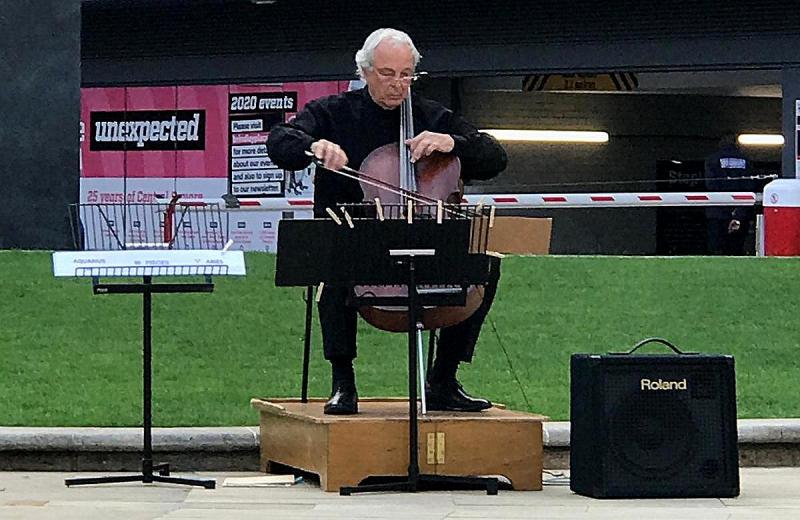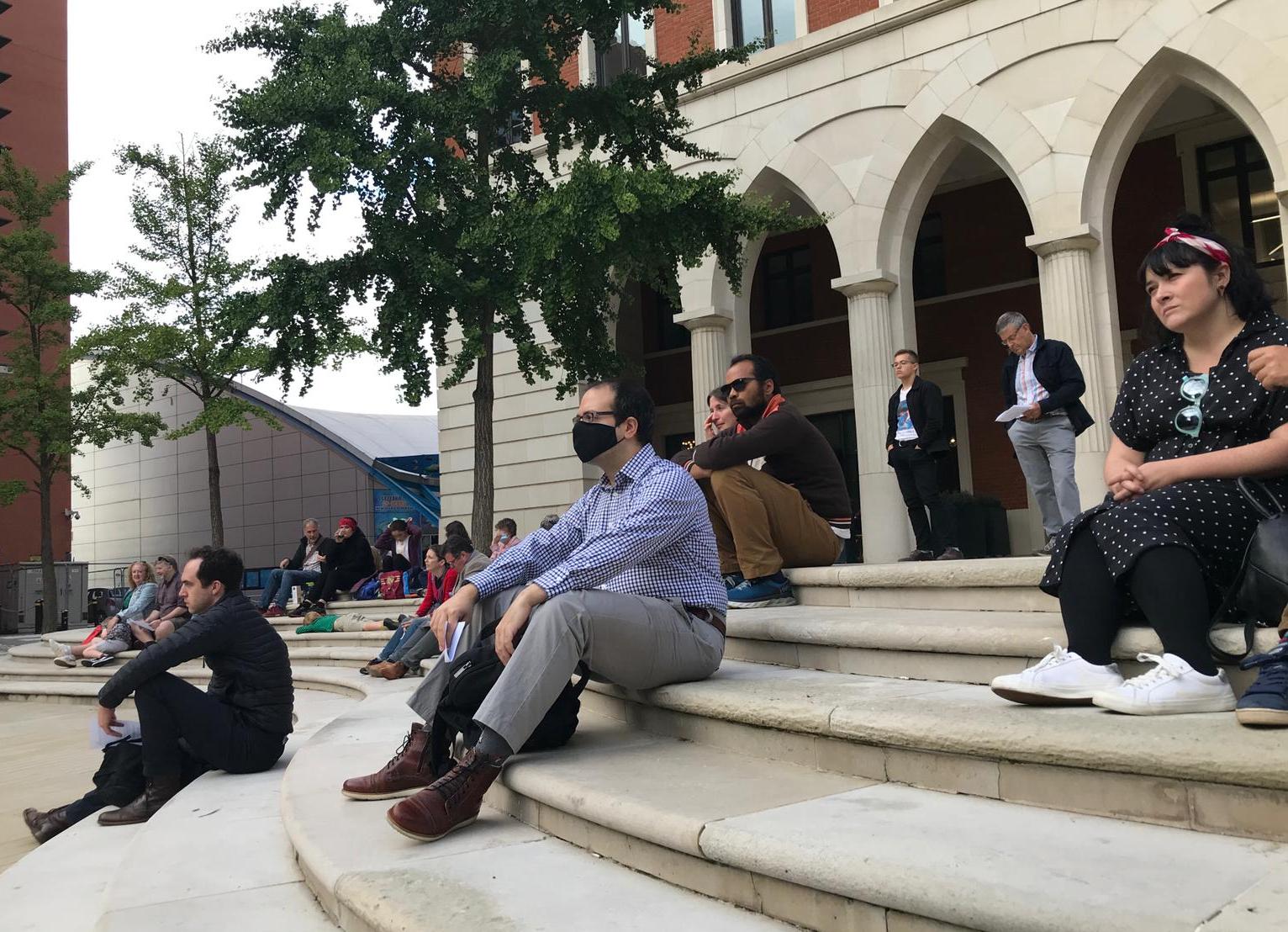BCMG, Heinen, Brindleyplace Birmingham review - from the concrete canyons to the stars | reviews, news & interviews
BCMG, Heinen, Brindleyplace Birmingham review - from the concrete canyons to the stars
BCMG, Heinen, Brindleyplace Birmingham review - from the concrete canyons to the stars
Solo Stockhausen achieves lift off, as live music returns to the Second City

Birmingham emerged from musical lockdown with Stockhausen. It couldn’t have been anyone else, really.
In fact, Birmingham Contemporary Music Group is about to travel to Hanover to participate in another rare performance of Sternklang. This was a sort of prelude to that adventure, planned in collaboration with the Ikon Gallery, and although it involved only one performer, it’s not really possible to describe anything by Stockhausen as small scale. The twelve brief, zodiac inspired melodies of Tierkreis are a lesson in how a single line of music can unlock an entire imaginative cosmology. Performed during rush hour in the central square of Brindleyplace by BCMG’s co-founder, the cellist Ulrich Heinen, they had to contend with the ambient noise of a whole conurbation – yet still managed to make their creator’s outsize personality felt.
It was one of those ideas that was just crazy enough to work. Brindleyplace is Birmingham’s not-particularly-subtle answer to Canary Wharf; a swagger of kitsch 1990s office blocks and chain restaurants plonked around landscaped squares and (currently inactive) fountains. Heinen had set up opposite a shuttered Costa Coffee in the largest square, his cello case propped next to a recycling bin. This open air performance, predicted BCMG’s artistic director in the free programme sheets, "links us back to nature and as Stockhausen puts it, the individual with the cosmic whole, 'preparing us for beings from other stars and their arrival’”.
He wasn’t joking about nature. A flock of seagulls had just hit town, announcing their arrival so enthusiastically that you’d have assumed that a trawlerload of herring had just been landed at Gas Street Basin. Cycle couriers and commuters on Bromptons freewheeled across the performance space, and a police car idled nearby, presumably to deal with unauthorised interplanetary visitors. None of this seemed to fluster Heinen, though even with his cello discreetly amplified, the shimmering textures of Bernd Alois Zimmermann’s Four Short Studies of 1970 – originally commissioned by Heinen’s teacher Siegfried Palm – simply dissolved amid the ambient noise. Henze’s Serenade fared better. There was something about Henze’s fundamental lyricism – the Italianate warmth that underlies its overcast melodies and quizzical gestures – that somehow managed to cut through, especially when carried by Heinen’s mellow but intensely centred tone. He spent great sprays of pizzicato arcing over the empty fountains; droplets of melody ricocheted off the concrete and brick of the surrounding office blocks, and hung in the air along with the car horns and generators.
Henze’s Serenade fared better. There was something about Henze’s fundamental lyricism – the Italianate warmth that underlies its overcast melodies and quizzical gestures – that somehow managed to cut through, especially when carried by Heinen’s mellow but intensely centred tone. He spent great sprays of pizzicato arcing over the empty fountains; droplets of melody ricocheted off the concrete and brick of the surrounding office blocks, and hung in the air along with the car horns and generators.
And then Stockhausen’s cosmic wheel began to spin. The composer supplies only a title and a single line of melody for each sign of the zodiac, though he does suggest that performers play each one at least three or four times before moving on. Heinen followed these instructions diligently, but although he insisted to me after the performance that he’d only added some minor touches of instrumental colour, he inflected each sequence so vividly that they barely seemed like repetitions – more an evolving, almost improvisatory, fantasy on Stockhausen’s pungently-characterised musical symbols.
The lyricism that had carried Henze’s ideas through the urban clamour was redoubled here – and as Heinen moved from Leo (because it’s August) through the chaste melodic gestures of Virgo, the flashing snap-pizzicati of Scorpio and the deep, booming song of Taurus, the imagination took over: with Heinen’s luminous, eloquent cello sound etching musical lines that seemed to glow, multicoloured, against the urban white noise of traffic and passing aircraft. And then he, and Stockhausen, came full circle; the vision faded, and Birmingham dropped softly back into our own universe. The policemen got into their car and drove away.
rating
Explore topics
Share this article
The future of Arts Journalism
You can stop theartsdesk.com closing!
We urgently need financing to survive. Our fundraising drive has thus far raised £49,000 but we need to reach £100,000 or we will be forced to close. Please contribute here: https://gofund.me/c3f6033d
And if you can forward this information to anyone who might assist, we’d be grateful.

Subscribe to theartsdesk.com
Thank you for continuing to read our work on theartsdesk.com. For unlimited access to every article in its entirety, including our archive of more than 15,000 pieces, we're asking for £5 per month or £40 per year. We feel it's a very good deal, and hope you do too.
To take a subscription now simply click here.
And if you're looking for that extra gift for a friend or family member, why not treat them to a theartsdesk.com gift subscription?
more Classical music
 Kanneh-Mason, Britten Sinfonia, Shave, Milton Court - a grin and a big beaming smile
A pair of striking contemporary pieces alongside two old favourites
Kanneh-Mason, Britten Sinfonia, Shave, Milton Court - a grin and a big beaming smile
A pair of striking contemporary pieces alongside two old favourites
 theartsdesk at the New Ross Piano Festival - Finghin Collins’ musical rainbow
From revelatory Bach played with astounding maturity by a 22 year old to four-hand jazz
theartsdesk at the New Ross Piano Festival - Finghin Collins’ musical rainbow
From revelatory Bach played with astounding maturity by a 22 year old to four-hand jazz
 First Person: Manchester Camerata's Head of Artistic Planning Clara Marshall Cawley on questioning the status quo
Five days of free events with all sorts of audiences around Manchester starts tomorrow
First Person: Manchester Camerata's Head of Artistic Planning Clara Marshall Cawley on questioning the status quo
Five days of free events with all sorts of audiences around Manchester starts tomorrow
 Goldscheider, Brother Tree Sound, Kings Place review - music of hope from a young composer
Unusual combination of horn, strings and electronics makes for some intriguing listening
Goldscheider, Brother Tree Sound, Kings Place review - music of hope from a young composer
Unusual combination of horn, strings and electronics makes for some intriguing listening
 theartsdesk Q&A: composer Donghoon Shin on his new concerto for pianist Seong-Jin Cho
Classical music makes its debut at London's K-Music Festival
theartsdesk Q&A: composer Donghoon Shin on his new concerto for pianist Seong-Jin Cho
Classical music makes its debut at London's K-Music Festival
 Helleur-Simcock, Hallé, Wong, Bridgewater Hall, Manchester review - moving lyricism in Elgar’s concerto
Season opener brings lyrical beauty, crisp confidence and a proper Romantic wallow
Helleur-Simcock, Hallé, Wong, Bridgewater Hall, Manchester review - moving lyricism in Elgar’s concerto
Season opener brings lyrical beauty, crisp confidence and a proper Romantic wallow
 Kohout, Spence, Braun, Manchester Camerata, Huth, RNCM, Manchester review - joy, insight, imagination and unanimity
Celebration of the past with stars of the future at the Royal Northern College
Kohout, Spence, Braun, Manchester Camerata, Huth, RNCM, Manchester review - joy, insight, imagination and unanimity
Celebration of the past with stars of the future at the Royal Northern College
 Jansen, LSO, Pappano, Barbican review - profound and bracing emotional workouts
Great soloist, conductor and orchestra take Britten and Shostakovich to the edge
Jansen, LSO, Pappano, Barbican review - profound and bracing emotional workouts
Great soloist, conductor and orchestra take Britten and Shostakovich to the edge
 Jakub Hrůša and Friends in Concert, Royal Opera review - fleshcreep in two uneven halves
Bartók kept short, and a sprawling Dvořák choral ballad done as well as it could be
Jakub Hrůša and Friends in Concert, Royal Opera review - fleshcreep in two uneven halves
Bartók kept short, and a sprawling Dvořák choral ballad done as well as it could be
 Hadelich, BBC Philharmonic, Storgårds, Bridgewater Hall, Manchester review - youth, fate and pain
Prokofiev in the hands of a fine violinist has surely never sounded better
Hadelich, BBC Philharmonic, Storgårds, Bridgewater Hall, Manchester review - youth, fate and pain
Prokofiev in the hands of a fine violinist has surely never sounded better
 Monteverdi Choir, ORR, Heras-Casado, St Martin-in-the-Fields review - flames of joy and sorrow
First-rate soloists, choir and orchestra unite in a blazing Mozart Requiem
Monteverdi Choir, ORR, Heras-Casado, St Martin-in-the-Fields review - flames of joy and sorrow
First-rate soloists, choir and orchestra unite in a blazing Mozart Requiem

Add comment